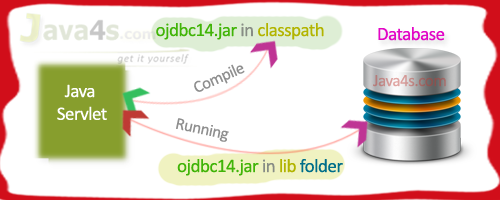| Newsletter |
How to Connect Servlet to the Database with Example
Servlets » on Feb 7, 2013 { 18 Comments } By Sivateja
Let us see how to connect servelet application with (Oracle) database, for time being i am considering Oracle XE. In our application i am going to display all the records from the table ‘Java4s‘.
- Make sure you have java4s table in the database with some data in it
- Make sure you have ojdbc14.jar file in your classpath and lib folder as well as [ why in two places ? 🙂 servlet will use ojdbc14.jar file which is in the classpath, for compiling the application, and ojdbc14.jar file in lib folder will be used at the time of running the servlet application], you can check the same in this figure…
Directory Structure
 |  |
Files Required
- index.html
- ServletDatabaseConnect.java
- web.xml
- ojdbc14.jar
index.html
<form action="show" method="post">
<font face="verdana" size="2">
Enter Table Name :<input type="text" name="table">
<input type="submit" value="Display">
</font>
</form>ServletDatabaseConnect.java
package java4s;
import java.io.IOException;
import java.io.PrintWriter;
import java.sql.Connection;
import java.sql.DriverManager;
import java.sql.ResultSet;
import java.sql.Statement;
import javax.servlet.ServletException;
import javax.servlet.http.HttpServlet;
import javax.servlet.http.HttpServletRequest;
import javax.servlet.http.HttpServletResponse;
public class ServletDatabaseConnect extends HttpServlet
{
protected void doPost(HttpServletRequest req,HttpServletResponse res)throws ServletException,IOException
{
PrintWriter pw=res.getWriter();
res.setContentType("text/html");
String tb=req.getParameter("table");
try
{
Class.forName("oracle.jdbc.driver.OracleDriver");
Connection con=DriverManager.getConnection("jdbc:oracle:thin:@localhost:1521:XE","system","admin");
Statement st=con.createStatement();
System.out.println("connection established successfully...!!");
ResultSet rs=st.executeQuery("Select * from "+tb);
pw.println("<table border=1>");
while(rs.next())
{
pw.println("<tr><td>"+rs.getInt(1)+"</td><td>"+rs.getString(2)+"</td>"+
"<td>"+rs.getString(3)+"</td></tr>");
}
pw.println("</table>");
pw.close();
}
catch (Exception e){
e.printStackTrace();
}
}
}web.xml
<web-app> <servlet> <servlet-name>ServletDBConnect</servlet-name> <servlet-class>java4s.ServletDatabaseConnect</servlet-class> </servlet> <servlet-mapping> <servlet-name>ServletDBConnect</servlet-name> <url-pattern>/show</url-pattern> </servlet-mapping> </web-app>
Output
 |  |
 |  |
You Might Also Like
::. About the Author .:: | ||
 | ||
Comments
18 Responses to “How to Connect Servlet to the Database with Example”



what is the difference between flush and commit?
Hello sir ! i love ur tutorial..u r doing great work…plz post also jdbc ,jsp and sir in servlet u dont cover all topic..plz also post session ,filter etc..thankx in advance
what the means of sqlexception?
and which situation it will come
plzz explain
Hi !!!!!
Can anyone explain filters in detail with code segments? like we have authentication filter , logging, data compression etc.
Sir ur tutorial is realy useful and could u pls add Servlet Chaining & session tracking in servlet
hi sir,
We are eagerly wait for web servies, please provide the implementation of web services ASAP. Thankx a lot.
hello sir,
i want webservice tutorials please provide webservices ASAP,we have so many websites but not equal to your explanation,your explanation is very neat and clearly please provide webservices
thank youuuuuuuu
First for providing all topics in software but i need jsp tutorials
jdbc ok
can u tell how to connect servlet and hibernate
login and registration form
Very helpful tutorial.Thank you
Making connection SQL server Database
Using the sqljdbc.jar class library, applications must first register the driver as follows:
Class.forName(“com.microsoft.sqlserver.jdbc.SQLServerDriver”);
When the driver is loaded, you can establish a connection by using a connection URL and the getConnection method of the DriverManager class:
String connectionUrl = “jdbc:sqlserver://localhost:1433;” +
“databaseName=AdventureWorks;user=MyUserName;password=*****;”;
Connection con = DriverManager.getConnection(connectionUrl);
Many thanks.
Thank you for good explaination.
Very help full tutorial but plz update complete topic and plz update jsp tutorial..
thanks sir for good explanation.
Thanks sir, I am expecting JSP tutorial Please….
Hello sir, I am getting the "connection established successfully…!!" message but, am not retrieve my table in the final output. so, please give me the advice. thank you
Please explain servlet filters and file uploading